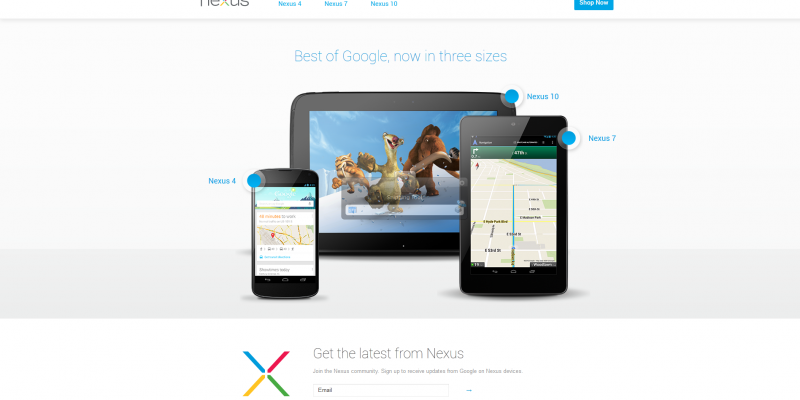The event may have been cancelled, but not even Hurricane Sandy can stop Google’s announcement today, no matter how hard Microsoft wishes. In a flurry of press releases, Google has announced a pair of new Nexus devices, a new version of Android, and new versions of the Nexus 7.
The Nexus 7 got a small price drop to bring it back in line with competitors like Amazon’s Kindle Fire HD. The 8 GB version is gone, and the 16 GB version is now $199. A new 32 GB version is $249, and a 32 GB plus 3G version is only $299. That means a 32 GB 3G Nexus 7 is $30 cheaper than the 16 GB WiFi-nly iPad Mini. WiFi versions of the Nexus are available from Google Play right now, with the 3G version coming soon.
Oddly absent from the Nexus announcements is any 4G LTE option. The 3G devices, especially tablets, have become increasingly rare over the last year. Verizon’s Galaxy Nexus has taught Google that an unlocked device with proprietary radios is a complicated proposition. Android 4.1 (Jelly Bean) went to the international Galaxy Nexus back in July, but Verizon users didn’t see the update until late September, completely eliminating the number one advantage of using a Nexus device in the first place. As a result, none of the devices announced today have an LTE or CDMA option. That means no Verizon, no Sprint, and no 4G LTE anywhere.
The Nexus 4 is Google’s newest flagship phone. Virtually every detail of this device was leaked in advance, but it remains an exciting launch for LG, which doesn’t have a reputation of bringing great Android devices to the U.S. and has never before built a Nexus device. The Nexus 4 will be available unlocked from the Google Play Store for $299 with 8 GB of storage or $349 with 16 GB. In the U.S., T-Mobile will offer the 16 GB version on contract for $199. These are surprisingly meager storage options to face off against the iPhone’s 16, 32, and 64 GB offerings and the Samsung Galaxy S3’s 16 and 32 GB choices. Google has been pushing for greater reliance on its cloud services lately, like Play Music and Drive, but this is a surprising move.
Qi wireless charging supports the Nexus 4, and Google will offer a charging dock that looks a lot like the short-lived Nexus Q or the defunct Palm Pre’s Touchstone (Google may not be in love with these examples). If you loved that Fatboy charger that Nokia announced for the new Lumia phones, that should also work. Other features include a Qualcomm Snapdragon S4 Pro processor, 2 GB of RAM, an 8 MP camera, and a 4.7” IPS display that nearly matches the pixel density of the iPhone’s Retina display (320 ppi to the iPhone’s 326 ppi).
The final device Google announced today is Android’s 10-inch iPad competitor, the Nexus 10. Google clearly made sure Samsung had the competition in mind when it designed this one. The Nexus 10 is nearly identical in thickness and weight to the iPad 2 (it missed the mark by 0.1 mm and 2 grams), despite its 18 month age difference. Matching size with such an old device is less than impressive unless you can improve on performance, though, and Samsung didn’t forget that. The Nexus 10 is the first Android tablet to top the iPad’s Retina display, with a massive 2560 x 1600 resolution, 300 ppi to the latest iPad’s 264. Hopefully the dual-core A15 processor, Mali T604 GPU, and 2 GB of RAM are powerful enough to drive all those pixels. The Nexus 10 is WiFi-only, and it comes in 16 GB and 32 GB flavors, for $399 and $499 respectively.
Google also brought us the latest version of Android today, version 4.2. The name is still Jellybean, indicating Google doesn’t consider this to be a major revision. Past unnamed versions have brought mostly behind-the-scenes performance improvements, with few new features, and this one is no exception. There are a few new perks, however. Here are some of the more notable ones.
- Miracast: A protocol for screensharing over WiFi, much like Apple’s AirPlay. Miracast, however, is an industry standard that will soon be built into many media devices, including TVs.
- Photo Sphere: A new panoramic picture taking option, allowing full 360 degree images like those from Google’s Street View cameras.
- Multiple user accounts: This allows users to share tablets, without sharing their apps and data. The next time you let your kids play Angry Birds, they won’t mess up your game progress.
- Gesture typing: In 4.1, the Android keyboard added a prediction engine much like the one offered by Swiftkey. Now, Google has added Swype-like typing, potentially reducing the importance of Swiftkey Flow. Apple is more commonly associated with snatching ideas from the App Store for its core OS, but apparently the Google Play store is not immune to this tactic.
[yframe url=’http://www.youtube.com/watch?v=pHuoDqcIyqk’]
The Nexus 4 and Nexus 10 will run Android 4.2 at launch. There’s no word yet on when the Nexus 7 and Galaxy Nexus will see these updates, but it probably won’t take long. We don’t yet know if the Nexus S will get this update, but the lack of a new name should mean this is a small enough change to work on anything that ran 4.1. That would make the Nexus S the first Android device to receive two full years worth of updates.
Both the Nexus 4 and Nexus 10 will be available starting November 13 from Google Play. If you’re in the market for a new phone or tablet, check them out.


Comments are closed.